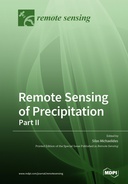Explore

Remote Sensing of Precipitation: Part II
0 Ungluers have
Faved this Work
Login to Fave
Precipitation is a well-recognized pillar in the global water and energy balances. The accurate and timely understanding of its characteristics at the global, regional and local scales is indispensable for a clearer insight on the mechanisms underlying the Earth’s atmosphere-ocean complex system. Precipitation is one of the elements that is documented to be greatly affected by climate change. In its various forms, precipitation comprises the primary source of freshwater, which is vital for the sustainability of almost all human activities. Its socio-economic significance is fundamental in managing this natural resource effectively, in applications ranging from irrigation to industrial and household usage. Remote sensing of precipitation is pursued through a broad spectrum of continuously enriched and upgraded instrumentation, embracing sensors which can be ground-based (e.g., weather radars), satellite-borne (e.g., passive or active space-borne sensors), underwater (e.g., hydrophones), aerial, or ship-borne. This volume hosts original research contributions on several aspects of remote sensing of precipitation, including applications which embrace the use of remote sensing in tackling issues such as precipitation estimation, seasonal characteristics of precipitation and frequency analysis, assessment of satellite precipitation products, storm prediction, rain microphysics and microstructure, and the comparison of satellite and numerical weather prediction precipitation products.
This book is included in DOAB.
Why read this book? Have your say.
You must be logged in to comment.
Rights Information
Are you the author or publisher of this work? If so, you can claim it as yours by registering as an Unglue.it rights holder.Downloads
This work has been downloaded 105 times via unglue.it ebook links.
- 105 - pdf (CC BY) at Unglue.it.
Keywords
- abrupt changes
- Agriculture
- annual maxima
- assessment
- bias correction
- cloud radar
- complex topography
- convective
- cyprus
- daily rainfall
- Data assimilation
- Discharge
- disdrometer
- diverse climate
- downscaling
- EDBF algorithm
- elevation
- ERA5
- error decomposition
- Evaluation
- extreme events
- extreme precipitation
- extreme rainfall
- field displacement
- Flood
- gauge data
- geographically and temporally weighted regression
- geographically and temporally weighted regression kriging
- geographically weighted regression
- geospatial predictor
- GNSS
- GNSS antenna
- GNSS ZTD
- goGPS
- GPM
- GPM IMERG
- gridded precipitation products
- ground radar
- GSMaP
- GSMaP_Gauge_NRT
- GSMaP_NRT
- high-impact rainfall events
- hourly rainfall
- hydrometeor
- hydrometeor classification
- IMERG
- IMERG-V05B and V06A
- Iran
- LDR
- Lightning
- linear trends
- Louisiana
- Mainland China
- microphysical processes
- morphing
- MSWEP
- Multi-Satellite Precipitation Analysis (TMPA)
- n/a
- nepal
- northern China
- numerical weather prediction
- object-based method
- optimum interpolation
- Pakistan
- Phase Center Variation
- polarimetric radar signatures
- precipitation
- precipitation estimation
- precipitation interpolation
- quantitative precipitation estimation
- quantitative precipitation estimation (QPE)
- Radar
- radar reflectivity
- radar reflectivity–rain rate relationship
- rain spectra
- raindrop size distribution
- raindrop size distribution (DSD)
- raindrop spectrometer
- Rainfall
- reanalysis
- receiver antenna calibration
- Reference, information & interdisciplinary subjects
- relative calibration
- Remote sensing
- Research & information: general
- satellite
- satellite precipitation
- satellite precipitation products
- satellite-based precipitation
- semi-arid area
- SEVIRI
- SM2RAIN
- SM2RAIN-ASCAT
- SM2RAIN-CCI
- soil moisture
- Southern China
- spatial bootstrap
- spatial pattern
- spatiotemporal analysis
- spring 2019
- statistical distribution
- statistical indicators
- storm events
- stratiform
- TAHMO
- Taiwan
- Thies
- thunderstorm
- Tianshan Mountains
- TIGGE
- time weight function
- Trends
- TRMM
- U-blox
- Validation
- weather circulations
- weighted precipitation
- WRF model
- ZED-F9P
- Zenith Tropospheric Delay
Links
DOI: 10.3390/books978-3-0365-2328-6Editions

